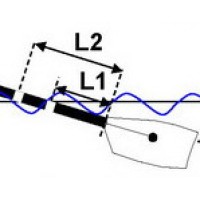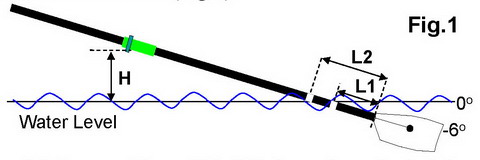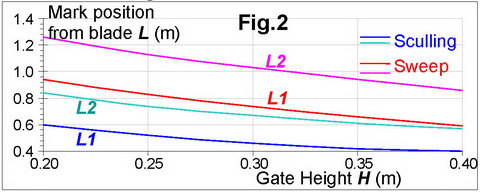Practical implications of axial oar forces

Recent BioRow research (RBN 2020/12, 2021/06-7) has found that the axial blade force is directed inwards to the pin from the catch to 0o oar angle (perpendicular position), then it is directed outwards. This means it plays a negative role in propulsion: it creates a braking force component in the opposite direction to the velocity of the rower-boat system. Therefore, the blade axial force must be minimised, and the following measures could be implemented:
- The blade surface must be as well painted, clean and smooth like the boat surface. Placement of any stickers or tapes on the blade increases its drag factor in the axial direction, creating an axial braking force.
- Blade work in the water must be at an optimal depth ŌĆō the top edge should be about half a spoons width below the water surface. Placement of the blade that is too deep increases its axial force and creates more drag. Another negative effect of ŌĆśdiggingŌĆÖ the oars is the increased drag created by the shaftŌĆÖs submersion into the water, and extra energy losses on the blade-shaft rotation in the water. A good method to control the blade depth is placement of some markers (e.g. white electric tape, RBN 2001/10) on the shaft, then during the drive, to keep the water surface in between the marks (Fig.1).

Marker positions (L1, L2) depend on the height of the bottom of the gate (H) from water level (Fig.2) and outboard length. Data below is given for outboards 2.00 m in sculling and 2.60 m in sweep: add 0.6 cm for each 1 cm of longer outboard and vice versa.

The axial handle force is created, when a pulling force applied by a rower is directed at an angle different from 90o to the oar shaft, so the handle force is decomposed into two components: normal and axial (RBN 2021/12). The axial handle force is a static one and creates no energy losses, because it is cancelled at the gate and there is no movement in its direction. The force decomposition at the handle works as a heavier gearing: it decreases the normal component of the handle force, but proportionally increases velocity in the normal direction compared to the pulling direction. This heavier gearing during the beginning of the drive has both positive and negative effects.
The positive points are: 1. Heavier gearing means higher velocity of output (handle and blade) at a lower velocity of input (rowerŌĆÖs body). After the catch, when the blade is only entering the water and forces are low, the heavier gearing makes angular oar acceleration faster, so connection of the blade with the water could be quicker, without backsplash and braking force. This allows for the rower to focus on the acceleration of their mass, rather than on acceleration of the handle by means of ŌĆ£openingŌĆØ their upper body. 2. It was found that the handle force decomposition corresponds very well with the pulling angle between the oar shaft and rowerŌĆÖs arm. This means the total handle force is directed straight along the arm, so the rower pulls the handle naturally in the most efficient way.
Negative effects of the axial handle force could be noticeable only when the blade is buried in the water and forces are significant: 1. Heavier gearing caused by the handle force decomposition makes pulling slower, increases drive time and may affect negatively rowing rhythm (ŌĆ£rushingŌĆØ on recovery) in attempt to maintain high racing stroke rate. This is especially noticeable at long catch angles. 2. If the handle moves too slow, it may decrease the rowerŌĆÖs efficiency, because muscles work in a slower static mode on the Hill curve (RBN 2007/09) and produce less power.
Rigging implications:
- The current recommendations for Fat2 blades to use the oar length / outboard 6cm shorter than in other blade types makes its gearing ratio and burden factor much lighter. In Fat2, the oar should be set to similar length as other types, or maybe just 2-3cm shorter.
- Too narrow of a span / long overlap should be avoided. Usually, narrower span is used to increase catch angles, keeping a comfortable finish handle position. Instead, it is better to proportionally decrease inboard / oar length and keep constant overlap, no more than 20cm. Before changing the rigging, it is always good to double check that the desired oar angles could be achieved with rowing technique improvement: optimal leg ŌĆ£compressionŌĆØ and trunk angle at catch, stretching out the arms and shoulders, adequate timing of the oar and rowerŌĆÖs body movement. It is also a good idea to check the pulling angles between the shaft and arm, which should not be less than 60o at the catch.
The above conclusions are related to sculling only. More studies on sweep oars are needed.
Acknowledgements: Thanks to Dick Dreissigacker and Alex Dunne of Concept2 Inc. for their support of this study.
┬®2022 Dr. Valery Kleshnev www.biorow.com



